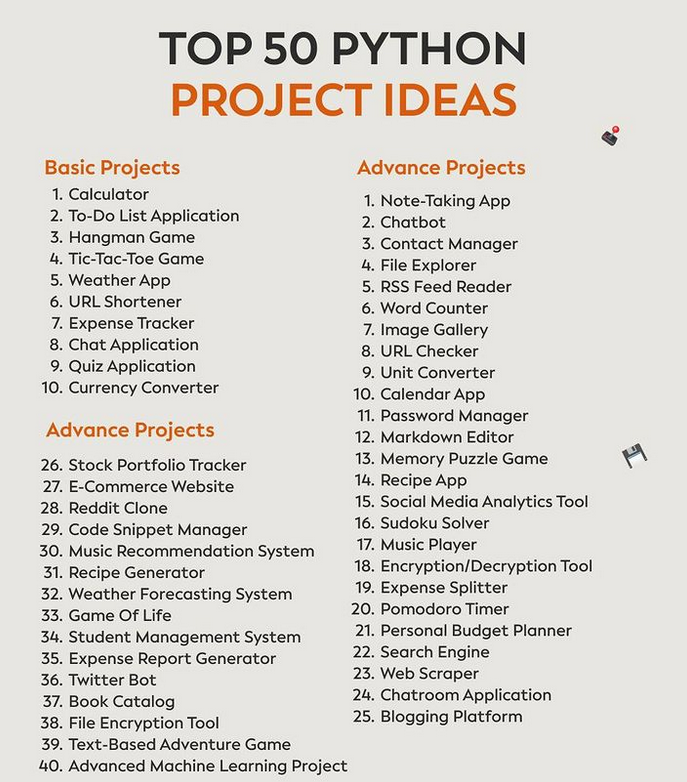Top 20 Python Project Ideas with Source Code in 2025
Table of Contents

Python is one of the best programming languages to learn, especially if you’re a beginner or simply a student or a coder. But why is Python such a good starting language? This is because Python is simple, clean and fast to implement, making it cross-domain and versatile. You can build web applications, automate things (boring!), or venture into data science—not to mention Python is often praised for its rich ecosystem of libraries!
So, what’s the best way to learn Python? The answer is – by building Python-based projects!
In this blog, we have done all of the heavy lifting (just kidding!) and created a list of the top 20 Python projects in 2025. It ranges from beginner mini-projects to advanced projects you could put on your resume, and you can use them in real-life scenarios.
Now, get your laptop, fire up your IDE, and let’s take a look at these awesome project ideas that you can start now. We’ve used detailed explanations, accompanied by source code for each project, so that you can copy and paste to start coding immediately. Let’s get started.
Best Python Project Ideas for 2025

Did you know that there are almost 8.2 million users globally, and Python is considered one of the most useful, simple, and widespread programming languages? Isn’t that wonderful? This language serves various applications and domains across different platforms. So, without a doubt, mastering Python can be a career-changing decision.
So, let’s explore the 20 best Python projects that you can work on to assess your skills:
1. Number Guessing Game
The Number Guessing Game is a very simple python project for beginners where the program will pick a random number within a certain range and the user will guess that number.
This Python project reinforces your skills of loops, conditionals and basic I/O in Python, and the end goal is that you have a working guessing game that tracks the user’s guesses.
Source Code:
import random
def number_guessing_game():
print(“Welcome to the Number Guessing Game!”)
number_to_guess = random.randint(1, 100)
attempts = 0
max_attempts = 10
print(“I’m thinking of a number between 1 and 100.”)
print(f”You have {max_attempts} attempts to guess it.”)
while attempts < max_attempts:
try:
guess = int(input(f”Attempt {attempts + 1}: Enter your guess: “))
attempts += 1
if guess == number_to_guess:
print(f”Congratulations! You guessed the number {number_to_guess} in {attempts} attempts!”)
break
elif guess < number_to_guess:
print(“Too low! Try again.”)
else:
print(“Too high! Try again.”)
except ValueError:
print(“Invalid input. Please enter a number.”)
if attempts == max_attempts and guess != number_to_guess:
print(f”Sorry, you’ve used all your attempts. The number was {number_to_guess}. Better luck next time!”)
if __name__ == “__main__”:
number_guessing_game()
2. Binary Search Algorithm Implementation
This is one of those easy Python projects where you will implement the binary search algorithm to find a target value in a sorted list. Binary search works by continually dividing the interval in half, which saves a lot of lookup time.
Source Code
Def binary_search(Arr, target
Low=0
High = len(arr)-1
While low<=high:
If arr(mid] = target
Return mid
3. To-Do List App
A to-do list app is one of the cool Python projects that will allow you to manage tasks in the command line interface and make it easy for users or yourself to manage tasks by providing add, delete, view, and complete tasks functionalities.
You can use Python’s sqlite3 library to create a database that stores tasks persistently, or even a simple text file for a less complex solution.
This app requires the use of CRUD (Create, Read, Update, and Delete) operations, as well as a navigational menu for task management. This project will give the option to learn about handling data (database or plain text I/O), but it requires a final project that is a simple and efficient task management system that has a terminal interface.
Source Code
import sqlite3
# Create the tasks table
def create_table():
conn = sqlite3.connect(“tasks.db”)
cursor = conn.cursor()
cursor.execute(“””CREATE TABLE IF NOT EXISTS tasks (
id INTEGER PRIMARY KEY AUTOINCREMENT,
task TEXT NOT NULL,
status TEXT NOT NULL DEFAULT ‘Pending’
)”””)
conn.commit()
conn.close()
# Add a new task to the list
def add_task(task):
conn = sqlite3.connect(“tasks.db”)
cursor = conn.cursor()
cursor.execute(“INSERT INTO tasks (task) VALUES (?)”, (task,))
conn.commit()
conn.close()
print(“Task added successfully!”)
# View all tasks in the list
def view_tasks():
conn = sqlite3.connect(“tasks.db”)
cursor = conn.cursor()
cursor.execute(“SELECT * FROM tasks”)
tasks = cursor.fetchall()
conn.close()
if tasks:
print(“\nYour To-Do List:”)
for task in tasks:
print(f”ID: {task[0]} | Task: {task[1]} | Status: {task[2]}”)
else:
print(“No tasks found!”)
# Delete a task by ID
def delete_task(task_id):
conn = sqlite3.connect(“tasks.db”)
cursor = conn.cursor()
cursor.execute(“DELETE FROM tasks WHERE id = ?”, (task_id,))
conn.commit()
conn.close()
print(“Task deleted successfully!”)
# Mark a task as completed by ID
def mark_task_complete(task_id):
conn = sqlite3.connect(“tasks.db”)
cursor = conn.cursor()
cursor.execute(“UPDATE tasks SET status = ‘Completed’ WHERE id = ?”, (task_id,))
conn.commit()
conn.close()
print(“Task marked as completed!”)
# Main application loop
def main():
create_table()
while True:
print(“\nTo-Do List App”)
print(“1. Add Task”)
print(“2. View Tasks”)
print(“3. Delete Task”)
print(“4. Mark Task as Completed”)
print(“5. Exit”)
choice = input(“Enter your choice: “)
if choice == “1”:
task = input(“Enter the task: “)
add_task(task)
elif choice == “2”:
view_tasks()
elif choice == “3”:
task_id = input(“Enter the task ID to delete: “)
if task_id.isdigit():
delete_task(int(task_id))
else:
print(“Invalid ID!”)
elif choice == “4”:
task_id = input(“Enter the task ID to mark as completed: “)
if task_id.isdigit():
mark_task_complete(int(task_id))
else:
print(“Invalid ID!”)
elif choice == “5”:
print(“Exiting the app. Goodbye!”)
break
else:
print(“Invalid choice. Please try again.”)
if __name__ == “__main__”:
main(
4. Rock, Paper, Scissors Game
The Rock, Paper, Scissors Game is another one of the most common yet popular fun, interactive Python projects. The user will play against the computer in a classic game of Rock, Paper, Scissors. The program will accept the user input of either rock, paper, or scissors while the computer makes a random choice using the random module built into Python. The rules are simple: rock beats scissors; scissors beats paper; paper beats rock. The purpose of this project is to practice and apply loops, conditionals, and randomness in the Python programming language. The result should be a fully functioning game where the user can choose to play as many rounds as they would like and display the result.
Source Code
import random
def get_computer_choice():
choices = [“rock”, “paper”, “scissors”]
return random.choice(choices)
def determine_winner(user_choice, computer_choice):
if user_choice == computer_choice:
return “It’s a tie!”
elif (user_choice == “rock” and computer_choice == “scissors”) or \
(user_choice == “scissors” and computer_choice == “paper”) or \
(user_choice == “paper” and computer_choice == “rock”):
return “You win!”
else:
return “Computer wins!”
def rock_paper_scissors():
print(“Welcome to Rock, Paper, Scissors!”)
while True:
user_choice = input(“\nEnter your choice (rock, paper, scissors): “).lower()
if user_choice not in [“rock”, “paper”, “scissors”]:
print(“Invalid choice. Please try again.”)
continue
computer_choice = get_computer_choice()
print(f”Computer chose: {computer_choice}”)
result = determine_winner(user_choice, computer_choice)
print(result)
play_again = input(“\nDo you want to play again? (yes/no): “).lower()
if play_again != “yes”:
print(“Thanks for playing! Goodbye!”)
break
if __name__ == “__main__”:
rock_paper_scissors()
5. Calculator
The Basic Calculator project performs addition, subtraction, multiplication, and division as per user selection. It allows the user to select the operation right away, input numbers, and return results. This shows functions, conditionals and user input validation in Python. In addition, you will implement error handling to address issues such as dividing by zero. The desired outcome is a functional command-line calculator with an intuitive menu for operation selection.
Source Code
def add(a, b):
return a + b
def subtract(a, b):
return a-b
def multiply(a, b):
return a * b
def divide(a, b):
try:
return a / b
except ZeroDivisionError:
return “Error: Division by zero is not allowed.”
def calculator():
print(“Welcome to the Basic Calculator!”)
while True:
print(“\nSelect an operation:”)
print(“1. Addition (+)”)
print(“2. Subtraction (-)”)
print(“3. Multiplication (*)”)
print(“4. Division (/)”)
print(“5. Exit”)
choice = input(“Enter your choice (1/2/3/4/5): “)
if choice == “5”:
print(“Thank you for using the calculator. Goodbye!”)
break
if choice in [“1”, “2”, “3”, “4”]:
try:
num1 = float(input(“Enter the first number: “))
num2 = float(input(“Enter the second number: “))
if choice == “1”:
print(f”The result is: {add(num1, num2)}”)
elif choice == “2”:
print(f”The result is: {subtract(num1, num2)}”)
elif choice == “3”:
print(f”The result is: {multiply(num1, num2)}”)
elif choice == “4”:
print(f”The result is: {divide(num1, num2)}”)
except ValueError:
print(“Invalid input. Please enter numeric values.”)
else:
print(“Invalid choice. Please select a valid operation.”)
if __name__ == “__main__”:
calculator()
6. Password Generator
The Password Generator is a convenient Python project for beginners that generates strong, secure passwords according to user-defined criteria, such as length and whether or not the password includes uppercase letters, numbers, and special characters.
It does this using Python’s random and string libraries to generate random combinations of characters, and because we leverage these two libraries, we can ensure that a strong level of security exists.
In this project, you will learn about string manipulation and randomisation while providing a practical utility. The result is a script that generates secure passwords for user preferences.
Source Code
import random
import string
def generate_password(length, include_uppercase, include_numbers, include_special_chars):
lower = string.ascii_lowercase
upper = string.ascii_uppercase if include_uppercase else ”
numbers = string.digits if include_numbers else ”
special_chars = string.punctuation if include_special_chars else ”
all_chars = lower + upper + numbers + special_chars
if not all_chars:
return “Error: At least one character set must be selected!”
password = ”.join(random.choice(all_chars) for _ in range(length))
return password
def password_generator():
print(“Welcome to the Password Generator!”)
try:
length = int(input(“Enter the desired password length: “))
if length <= 0:
print(“Password length must be greater than 0.”)
return
include_uppercase = input(“Include uppercase letters? (yes/no): “).lower() == ‘yes’
include_numbers = input(“Include numbers? (yes/no): “).lower() == ‘yes’
include_special_chars = input(“Include special characters? (yes/no): “).lower() == ‘yes’
password = generate_password(length, include_uppercase, include_numbers, include_special_chars)
print(f”\nYour generated password is: {password}”)
except ValueError:
print(“Invalid input. Please enter a numeric value for length.”)
if __name__ == “__main__”:
password_generator()
7. Chatbot Using NLP
The Chatbot Using NLP’s Python project consists of creating a chatbot that interacts with users with intelligent responses using natural language processing. You can perform simple NLP using NLTK and a basic neural net with TensorFlow or Keras. Key Concepts: Natural Language Processing, Machine Learning, Tokenisation, Intents.
Source Code:
import random
import json
import nltk
import numpy as np
from nltk.stem import WordNetLemmatizer
from tensorflow.keras.models import load_model
lemmatizer = WordNetLemmatizer()
intents = json.loads(open(‘intents.json’).read())
words = pickle.load(open(‘words.pkl’, ‘rb’))
classes = pickle.load(open(‘classes.pkl’, ‘rb’))
model = load_model(‘chatbot_model.h5’)
def clean_up_sentence(sentence):
sentence_words = nltk.word_tokenize(sentence)
return [lemmatizer.lemmatize(word.lower()) for word in sentence_words]
def bow(sentence, words):
sentence_words = clean_up_sentence(sentence)
bag = [0]*len(words)
for s in sentence_words:
for i, w in enumerate(words):
if w == s: bag[i] = 1
return np.array(bag)
def predict_class(sentence):
bow_msg = bow(sentence, words)
res = model.predict(np.array([bow_msg]))[0]
return np.argmax(res)
def get_response(intent_index):
tag = classes[intent_index]
for i in intents[‘intents’]:
if i[‘tag’] == tag:
return random.choice(i[‘responses’])
def chatbot_response(msg):
intent_index = predict_class(msg)
return get_response(intent_index)
def chat():
print(“Bot: Hi! Type ‘quit’ to exit.”)
while True:
msg = input(“You: “)
if msg.lower() == ‘quit’:
print(“Bot: Goodbye!”)
break
print(f”Bot: {chatbot_response(msg)}”)
chat()
8. Weather App
Have you ever wondered how weather apps fetch live data from online? In this Python project, you will learn how to create your own weather application using Python. By utilising the OpenWeatherMap API along with Python’s Tkinter GUI library, you will learn how to retrieve current weather data and present it in an attractive, user-friendly window.
This is one of the most useful Python mini projects that teaches you to use APIs, parse JSON data, and build simple GUI interfaces in Python, all at once. It is a useful Python project for beginners who want to have a better understanding of how real apps work behind the scenes.
Key Concepts: APIs, JSON, GUI
Source Code:
import tkinter as tk
import requests
def get_weather():
city = city_entry.get()
api_key = ‘YOUR_API_KEY’ # Replace with your OpenWeatherMap API key
url = f”http://api.openweathermap.org/data/2.5/weather?q={city}&appid={api_key}&units=metric”
try:
response = requests.get(url)
data = response.json()
if data.get(‘cod’) != 200:
result_label.config(text=f”City not found.”)
return
city_name = data[‘name’]
temperature = data[‘main’][‘temp’]
weather = data[‘weather’][0][‘description’]
humidity = data[‘main’][‘humidity’]
wind_speed = data[‘wind’][‘speed’]
weather_info = (
f”City: {city_name}\n”
f”Temperature: {temperature}°C\n”
f”Weather: {weather.title()}\n”
f”Humidity: {humidity}%\n”
f”Wind Speed: {wind_speed} m/s”
)
result_label.config(text=weather_info)
except Exception as e:
result_label.config(text=”Error fetching data.”)
# GUI setup
root = tk.Tk()
root.title(“Weather App”)
tk.Label(root, text=”Enter City Name:”, font=(“Arial”, 14)).pack(pady=10)
city_entry = tk.Entry(root, font=(“Arial”, 14))
city_entry.pack(pady=5)
get_button = tk.Button(root, text=”Get Weather”, command=get_weather, font=(“Arial”, 12))
get_button.pack(pady=10)
result_label = tk.Label(root, text=””, font=(“Arial”, 12), justify=tk.LEFT)
result_label.pack(pady=20)
root.mainloop()
9. File Organiser Script
Are you tired of messy download folders? This useful Python script will assist you in decluttering your folders by sorting files into different categories, such as Images, Documents, Videos, Music, etc,. based on the file extensions. It scans your target folder, identifies the file types, and moves each file into its corresponding folder. It’s one of those practical Python based projects that you should do to practice file handling, directory operations, and automation in Python. If you are looking for a fun Python project and you are a beginner, this is a Python project you should really try to make your ordinary workflow even more efficient.
Key Concepts: File I/O, OS module
Source Code:
import os
import shutil
def organize_files(folder_path):
for file in os.listdir(folder_path):
file_path = os.path.join(folder_path, file)
if os.path.isfile(file_path):
ext = file.split(‘.’)[-1]
ext_folder = os.path.join(folder_path, ext)
If not os.path.exists(ext_folder):
os.makedirs(ext_folder)
shutil.move(file_path, os.path.join(ext_folder, file))
organize_files(“C:/Users/YourUsername/Downloads“)
10. Alarm Clock
Make a simple, but functional alarm clock using the time module in Python and Tkinter for the graphical user interface. Users can set the alarm time, and when it is time to wake up, the app plays a noise or prints a message. This is a good Python project to start with in Python because it introduces time-based functions, event handling and GUI design fundamentals in a fun way.
Key Concepts: GUI, Time-based operations
Source Code:
from tkinter import *
import datetime
import time
import winsound
import threading
def alarm(set_time):
while True:
time.sleep(1)
if datetime.datetime.now().strftime(“%H:%M”) == set_time:
winsound.PlaySound(“alarm.wav”, winsound.SND_LOOP)
def set_alarm():
alarm_time = entry.get()
threading.Thread(target=alarm, args=(alarm_time,), daemon=True).start()
root = Tk()
root.title(“Alarm Clock”)
entry = Entry(root, font=(‘Arial’, 18))
entry.pack()
Button(root, text=”Set Alarm”, command=set_alarm).pack()
root.mainloop()
11. QR Code Generator
Develop a Python application that will create QR codes from text, links, or contact information using the third-party package called qrcode.
This is an easy Python project for beginner to advanced engineers that will help you get started using a third-party package and encoding data in terms of a visual representation. If you want to share a URL, show someone a message, or link to your online digital business card, this will do the trick—and more so, it’s a good way to learn about data representation.
Key Concepts: Image generation, Encoding, qrcode library
Source Code:
import qrcode
def generate_qr(data, filename=”qr_code.png”):
qr = qrcode.QRCode(version=1, box_size=10, border=5)
qr.add_data(data)
qr.make(fit=True)
img = qr.make_image(fill=”black”, back_color=”white”)
img.save(filename)
print(f”QR Code saved as {filename}”)
generate_qr(“https://www.python.org”)
12. Quiz App
Develop a multiple-choice quiz program in Python using the Tkinter library.
This Python project for students helps them to learn about GUI components (buttons, labels, frames) and how to control the flow of questions while processing users’ responses at the end. You can easily implement scoring, navigation between questions, and a culminating results screen. This is a fun way to practice building logic along with designing a user interface, and it’s a wonderful way to reinforce basic programming concepts!
Key Concepts: GUI, Event-driven programming, Lists
Source Code:
from tkinter import *
questions = [
(“What is the capital of France?”, “Paris”, [“Paris”, “London”, “Berlin”, “Rome”]),
(“What is 2 + 2?”, “4”, [“3”, “4”, “5”, “6”]),
(“Which language is this quiz written in?”, “Python”, [“Java”, “Python”, “C++”, “HTML”])
]
class Quiz:
def __init__(self, master):
self.master = master
self.index = 0
self.score = 0
self.q_text = StringVar()
self.q_label = Label(master, textvariable=self.q_text, font=(‘Arial’, 16))
self.q_label.pack(pady=20)
self.options = []
for i in range(4):
btn = Button(master, font=(‘Arial’, 14), command=lambda i=i: self.check_answer(i))
btn.pack(pady=5)
self.options.append(btn)
self.display_question()
def display_question(self):
question, _, options = questions[self.index]
self.q_text.set(question)
for i, option in enumerate(options):
self.options[i][‘text’] = option
def check_answer(self, i):
if self.options[i][‘text’] == questions[self.index][1]:
self.score += 1
self.index += 1
if self.index < len(questions):
self.display_question()
else:
self.q_label.config(text=f”Quiz Over! Your score: {self.score}/{len(questions)}”)
for btn in self.options:
btn.destroy()
root = Tk()
root.title(“Quiz App”)
quiz = Quiz(root)
root.mainloop()
13. Countdown Timer
Using Python and Tkinter, create a countdown timer application that takes a user input for a time duration and visually counts down to zero as the time passes. This beginner-friendly Python project topic will introduce you to concepts such as working with the time module, accepting user input, updating GUI elements in quasi-real-time, and generating alerts when the timer is completed. This is an excellent way to experience working with time-based logic as well as user interface style logic.
Key Concepts: Time module, GUI update loop
Source Code:
from tkinter import *
import time
def start_timer():
try:
countdown_time = int(entry.get())
while countdown_time > 0:
mins, secs = divmod(countdown_time, 60)
time_str = ‘{:02d}:{:02d}’.format(mins, secs)
label.config(text=time_str)
root.update()
time.sleep(1)
countdown_time -= 1
label.config(text=”Time’s Up!”)
except ValueError:
label.config(text=”Enter a valid number.”)
root = Tk()
root.title(“Countdown Timer”)
entry = Entry(root)
entry.pack()
button = Button(root, text=”Start Timer”, command=start_timer)
button.pack()
label = Label(root, font=(‘Helvetica’, 48))
label.pack()
root.mainloop()
14. Expense Tracker
Create a simple command-line expense tracker that lets users log daily expenses and save them to a CSV file. The program will enable the user to enter the date, category, and amount spent, and will allow them to calculate total expenses over time. This one of the crucial Python project topics will allow you to learn about file handling, using the CSV module and some basic data analysis. This is a practical way to learn a small bit about dealing with data and organising it efficiently.
Source Code:
import csv
import os
def add_expense():
item = input(“Enter item: “)
amount = float(input(“Enter amount: “))
with open(“expenses.csv”, mode=”a”, newline=””) as file:
writer = csv.writer(file)
writer.writerow([item, amount])
print(“Expense added.”)
def view_expenses():
if not os.path.exists(“expenses.csv”):
print(“No expenses found.”)
return
total = 0
with open(“expenses.csv”, newline=””) as file:
reader = csv.reader(file)
for row in reader:
print(f”{row[0]}: ${row[1]}”)
total += float(row[1])
print(f”Total expenses: ${total}”)
while True:
print(“\n1. Add Expense\n2. View Expenses\n3. Exit”)
choice = input(“Choose an option: “)
if choice == ‘1’:
add_expense()
elif choice == ‘2’:
view_expenses()
elif choice == ‘3’:
break
else:
print(“Invalid option.”)
15. Image Converter
Create a Python tool that converts images between formats like JPG and PNG using the Pillow library. This one of the easiest Python projects is perfect for beginners looking to explore image processing.
You can enhance the functionality by adding options for resizing, cropping, or applying basic filters. It’s a great hands-on way to learn how to manipulate visual data and interact with files using external libraries in Python.
from PIL import Image
def convert_image(file_path, output_path):
img = Image.open(file_path)
img.save(output_path)
convert_image(‘input.jpg’, ‘output.png’)
16. Currency Converter
Implement a currency converter in Python that allows users to get live exchange rates from an online API. Users can enter the amount and select currencies to see the converted value immediately. It teaches beginners how to make requests to APIs, parse JSON, and do some basic math.
This Python project can give learners a good learning experience and a practical application that simulates how Python can connect to external data sources and how to build simple applications with real-world functions.
Source Code:
import requests
def convert_currency(amount, from_currency, to_currency):
url = f”https://api.exchangerate-api.com/v4/latest/{from_currency}”
response = requests.get(url)
data = response.json()
rate = data[‘rates’][to_currency]
return amount * rate
print(convert_currency(100, ‘USD’, ‘EUR’))
17. Web Scraper
Create a Python script that will scrape websites, for example, news headlines or product listings, using libraries such as BeautifulSoup or Scrapy.
With the help of this Python project will demonstrate many of the basics of web scraping, including parsing HTML, navigating DOM elements and reading HTTP requests. This can be a useful skill to automatically collect and analyse data, making it particularly interesting for new data scientists, researchers, or anyone creating real-time information tools.
Source Code:
import requests
from bs4 import BeautifulSoup
url = ‘https://news.ycombinator.com/’
response = requests.get(url)
soup = BeautifulSoup(response.text, ‘html.parser’)
for item in soup.select(‘.storylink’):
print(item.text)
18. Desktop Notepad
If you want to create a simple desktop notepad application with Python’s Tkinter library, this simple text editor will allow you to write and manage text files, which comes with most of the basic functionality, such as open, save, cut, copy, and paste.
The Desktop Notepad Python project is designed to be a hands-on approach to allow you to learn about GUI development, event handling, and reading/writing to files. It is a perfect project for beginners to combine creative development, functionality, and usability.
Source Code
import tkinter as tk
from tkinter import filedialog
def save_file():
file = filedialog.asksaveasfile(defaultextension=’.txt’, filetypes=[(“Text files”, “*.txt”)])
if file:
file.write(text_area.get(1.0, tk.END))
file.close()
root = tk.Tk()
root.title(“Simple Notepad”)
text_area = tk.Text(root)
text_area.pack()
menu = tk.Menu(root)
root.config(menu=menu)
file_menu = tk.Menu(menu)
menu.add_cascade(label=’File’, menu=file_menu)
file_menu.add_command(label=’Save’, command=save_file)
root.mainloop()
19. Typing Speed Test
Build a typing speed test application that tracks how fast a user types a specific sentence or paragraph. This app calculates the typing speed in Words Per Minute (WPM) and indicates typing errors so the user can better understand their accuracy when typing.
In this Python project, users can develop typing skills, and it will help teach about string manipulation, timing, as well as user interaction. Overall, this is a simple, fun and educational project for beginner Python programmers.
Source Code:
import time
def typing_test():
test_text = “Python is an amazing programming language.”
print(“Type this:”)
print(test_text)
input(“Press Enter when ready…”)
start = time.time()
typed = input(“\nStart typing: “)
end = time.time()
speed = len(typed.split()) / ((end – start) / 60)
print(f”Your speed: {speed:.2f} WPM”)
typing_test()
20. Chat Room with Socket Programming
Build a basic chat room using sockets where multiple users can connect and chat. This Python project teaches networking basics.
Source Code:
# Server
import socket
import threading
server = socket.socket(socket.AF_INET, socket.SOCK_STREAM)
server.bind((‘localhost’, 12345))
server.listen()
clients = []
def handle_client(client):
while True:
try:
msg = client.recv(1024)
broadcast(msg, client)
except:
clients.remove(client)
client.close()
break
def broadcast(msg, sender):
for client in clients:
if client != sender:
client.send(msg)
while True:
client, _ = server.accept()
clients.append(client)
threading.Thread(target=handle_client, args=(client,)).start()
# Client
import socket
import threading
def receive():
while True:
try:
msg = client.recv(1024).decode()
print(msg)
except:
print(“Disconnected from server”)
break
def send():
while True:
msg = input()
client.send(msg.encode())
client = socket.socket(socket.AF_INET, socket.SOCK_STREAM)
client.connect((‘localhost’, 12345))
threading.Thread(target=receive).start()
threading.Thread(target=send).start()
In The End
In a nutshell, Python projects are a great way to boost your coding skills and gain hands-on experience. There are many projects available for everyone, from beginners to experienced engineers, that help you understand how syntax, functions, and conditions work. Additionally, these projects can serve as a foundation for building more complex applications, like responsive websites or games, which can further enhance your career.
So, as a software engineer, are you ready to excel in your career? If yes, join Jaro Education, which is India’s leading online higher education and upskilling company. We offer a wide range of online degree programs and certification courses that not only help you work on real-world Python projects but also enhance your knowledge as an engineer. Visit our website to explore our Python and Data Science courses.
Frequently Asked Questions
Can Python replace SQL?
Not really. Python can work with databases using tools like SQLite, SQLAlchemy, and Pandas, but it doesn’t replace SQL. SQL is designed specifically for managing and querying large amounts of data quickly. Python is better for analysing that data and automating tasks.
Can you do web development with Python?
Yes, absolutely! Python is great for building websites. You can use frameworks like:
- Django – for full-featured web apps
- Flask – for simple and flexible web apps
- FastAPI – for creating fast APIs
Python handles the backend, but you’ll still need HTML, CSS, and JavaScript for the frontend (the part users see).
Can AI replace Python?
No, AI won’t replace Python. In fact, Python is one of the main languages used to build AI systems. Tools like TensorFlow, PyTorch, and Pandas are all based on Python. AI might help developers write code, but it can’t replace the power and flexibility that Python offers.
What is the future of Python in 2025?
Python’s future looks very promising in 2025. It’s already super popular and will likely grow even more, especially in areas like AI, machine learning, data science, and automation. Instead of replacing developers, AI will more likely become a helpful assistant, and Python will stay at the heart of it all.

















